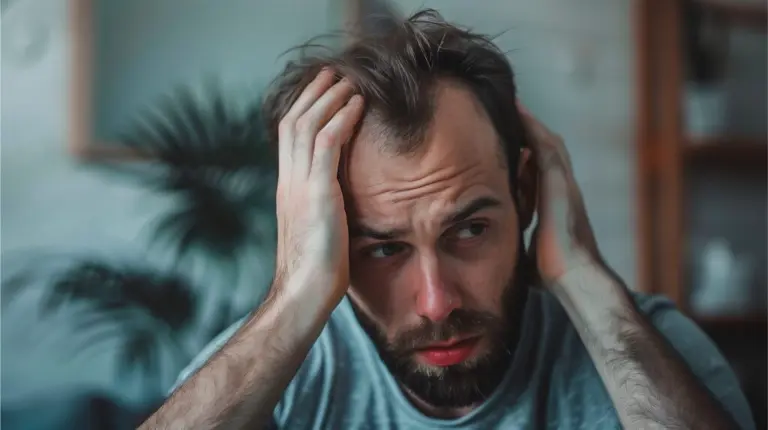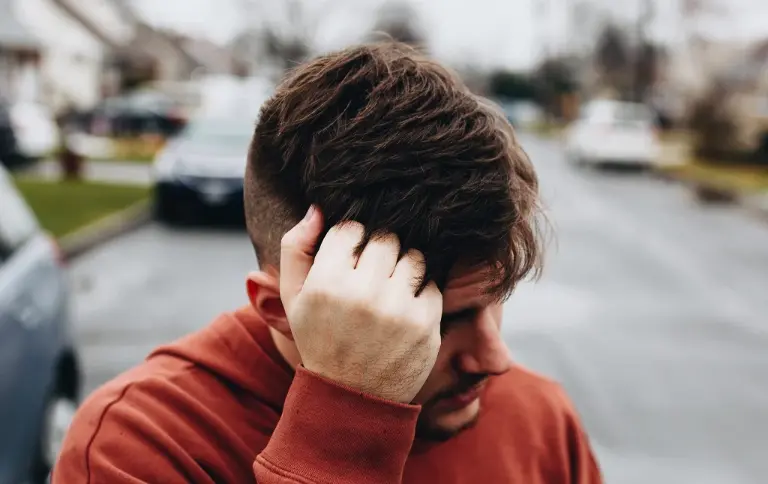Early on, balding can be challenging and might cause you to lose confidence. It can change your perspective on your social contacts and yourself. Many struggle to control the emotional toll early hair loss takes. Often accompanying balding at a young age are mental health problems like stress or anxiety.
Early hair loss has several different reasons. Common varieties are also androgenic alopecia, or genetic hair loss, and traction alopecia, from tight hairstyles. Additionally causing female pattern hair loss are hormonal imbalances in disorders like PCOS. Worse hair thinning can result from stress, inadequate diet, and lifestyle choices.
Fortunately, young men and women have ways to control their hair loss. Some types of hair loss can be slowed down or reversed using hair loss therapies include finasteride or Minoxidil. Better diet among other lifestyle modifications can help hair grow. Additionally preventing more hair loss is stress management and correcting bad hair care practices. Early hair loss prevention would help one to keep a healthy scalp and boost confidence.
Causes of Hair Loss at a Young Age
Genetic Hair Loss (Androgenic Alopecia)
Particularly in young men’s hair loss, androgenic alopecia is one of the main reasons for balding at a young age. Usually starting as a bald spot on the crown of the head or a receding hairline, this kind of hair loss The hair follicles shrink with time to produce thinner hair strands until the hair stops growing altogether. Male pattern baldness develops in significant part depending on a person’s family history. You are more likely to create similar problems if your parents or close relatives have gone bald or thinned their hair. Early intervention can slow down and assist in controlling androgenic alopecia.
Alopecia Areata
The autoimmune disorder known as alopecia areata results in uneven hair loss over the scalp, including tiny, circular bald patches. This results from the immune system attacking healthy hair follicles, so upsetting hair development. Though the precise reason is unknown, prominent factors are stress, disease, and genetics. Developing at any young age, alopecia areata might come and go randomly. Although some cases become chronic, early diagnosis can assist in encouraging hair growth by means of treatments.
Traction Alopecia
Tight hairstyles include braids, buns, or ponytails cause recurrent tension on hair follicles that culminates in traction alopecia. This continuous pulling weakens the follicles, which causes slow hair loss and finally results in the hair stopping growth in the impacted areas. Untreated traction alopecia may cause severe damage and irreversible hair loss. Early intervention—that is, style changes—can stop more damage.
Hormonal Disorders and Female Pattern Baldness
Though it is less frequent in young women, female pattern hair loss can be brought on by hormonal abnormalities like postpartum changes or polycystic ovarian syndrome (PCOS). Women hardly ever get bald spots, unlike men. Rather, they notice hair loss as slow thinning over the whole scalp. Hormonal therapies can slow down the progression and promote hair growth if the early onset of female pattern baldness occurs. Proper management of this kind of hair loss depends on the identification and correction of the hormonal imbalance.
Malnutrition and Lifestyle Factors
Additionally, balding at a young age is caused by a poor diet devoid of vital nutrients. Nutritional deficits—particularly in iron, zinc, and vitamin D—cause hair thinning and disturbance of hair development. Those with eating problems or poor eating habits might have hair loss, including from starvation. Retaking a good diet that nourishes hair follicles will help to undo the effects of this kind of hair loss. Furthermore, underlining the need for stress management for good hair are high-stress levels triggering disorders like alopecia areata and aggravating androgenic alopecia.
Signs to Look for If You’re Experiencing Early Hair Loss
Timeliness in treatment depends on early recognition of baldness in young people. The first indication is hair thinning or the development of little bald patches on the temple or head. Men might have a receding hairline, which is the first sign of male pattern baldness. Usually, women find hair loss across the scalp by slow thinning rather than clearly defined bald areas.
Another warning indicator is hair loss, which involves more shedding. Should your hair fall out more often after brushing or washing or if hair growth appears slower, it could indicate underlying problems such as hormone imbalances, stress, or inadequate diet. Also, young men and women suffer from patchy hair loss from an autoimmune disorder called alopecia areata.
Look for early indicators of androgenic alopecia or female pattern baldness in your family history. Should your parents or close relatives have suffered this kind of hair loss, you can begin to lose hair early, too. Early identification and treatment can help preserve normal hair follicles and slow down early balding development. Knowing these indicators will help you to be ready to act before the problem gets worse.
Psychological Impact of Balding at a Young Age
Early balding can lead to concern and compromise self-esteem. When someone notices hair loss, many people become self-conscious—especially if it begins with a receding hairline or obvious bald patches. Men and women suffer with the societal shame associated with hair thinning. Comparatively, to others, young people sometimes find it difficult, which can lower confidence and cause stress.
Control of stress is crucial since it aggravates alopecia areata and accelerates hair loss in young men and women. Using mindfulness or relaxation practices advances emotional well-being and helps lower stress.
Coping with balding at a young age depends much on support systems. Talking to friends, relatives, or others going through comparable problems might soothe you and offer doable advice. Self-esteem can also be raised by positive coping mechanisms, including accepting hair thinning in line with a fresh, confidence-building haircut. While women with female pattern baldness use loose styles or hairpieces to create volume, many men with male pattern baldness choose buzz cuts. Accepting hair loss, including changes in appearance, promotes a better attitude and increases long-lasting confidence.
Effective Hair Loss Treatments for Young Adults
Medical Treatments
- Popular topical medication minoxidil stimulates dormant hair follicles, therefore encouraging hair growth. Applied straight to bald patches or thinning hair, it helps slow down hair thinning.
- An oral drug for male pattern baldness is finasteride (Propecia). It acts by suppressing the hormone causing hair follicle shrinkage, so slowing down receding hairlines and lessening of more hair loss.
- Women with PCOS-caused female pattern baldness or hair loss will find hormonal treatments helpful. These therapies bring hormonal equilibrium back and promote good hair growth.
Lifestyle Changes and Supplements
- Healthy hair follicles and increased hair growth are supported by supplements including zinc, iron, and vitamin D. One primary reason for hair loss, including in young adults, is iron shortage.
- To stop hair loss, a balanced diet high in nutrients is absolutely vital. A good diet helps prevent early baldness brought on by starvation.
- Conditions like alopecia areata and traction alopecia cannot be avoided except by controlling stress. Stress might slow down healing and aggravate the already thinning of the hair. Adding yoga or mindfulness practices to your program will help you stay emotionally balanced.
Hair Transplants and Hair Replacement Systems
- HMoving healthy hair follicles from one section of the scalp to bald patches or hair thinning is the basis of hair transplants For many people, this operation provides a permanent fix for early-life baldness. Still, it can be expensive and not appropriate for everyone.
- For individuals who would choose non-surgical solutions, hair replacement devices offer temporary substitutes. These systems combine premium hairpieces that naturally complement current hair. For those who seek an instant confidence boost without medical assistance and are balding young-agers, they are perfect.
Early action with the correct therapies and lifestyle changes can slow down or even stop young age balding. The kind of hair loss and personal preferences will determine the suitable remedy. Seeing a doctor will enable you to choose the best course of action to properly control your illness.
Hair Care Tips to Prevent Further Hair Loss
Good hair care can help to slow down early balding and shield your hair follicles from injury. Steer clear of tight hairstyles like braids or ponytails since they might create traction alopecia from too much tension on the hair. More relaxed looks help to ease anxiety and stop irreversible hair thinning.
Heat tools without protection can cause dryness and breakage as well as weakening of hair. Apply heat protectants while styling to reduce damage and stop early indicators of a declining hairline. Eliminating heat entirely can also help to encourage over time better hair development.
Maintaining healthy hair follicles requires using mild shampoos. Products with solid chemicals might aggravate hair loss and slow down hair development. Search for shampoos and conditioners devoid of sulfates that feed the scalp and promote hair development.
Frequent massages of the scalp can increase blood flow to your hair follicles, so promoting hair growth. A few minutes each day massaging your scalp promotes thicker, better hair. Including these hair care techniques in your regimen will help to slow down the early balding process and encourage more muscular, better hair.
Coping with Hair Loss: Embracing Change and Confidence
Early balding can be more manageable if you make careful cosmetic adjustments. Many men with male pattern baldness choose close-cropped or buzz cuts, which help to enhance confidence. Growing facial hair—such as a beard—may help to deflect bald patches or a fading hairline.
Hair fibers or makeup can assist ladies with female pattern hair loss or hair thinning look to have fuller hair. Applying these simple methods will help greatly increase confidence.
For emotional support, web communities or support groups can be pretty helpful. Speaking with individuals who have hair loss—including male pattern baldness—allows you to learn coping mechanisms and exchange experiences. Early acceptance of the adjustments and a good attitude help you to keep your confidence all along the road.
Final Thought
Although early balding can be overwhelming, also early intervention helps properly control the issue. Treatments like Minoxidil and Finasteride reduce the spread of hair loss and support good hair growth. Apart from medical procedures, lifestyle modifications including appropriate diet, stress control, and scalp care enhance results as well.
Long-term hair condition depends on preventative maintenance. Managing stress and avoiding tight hairstyles that lead to traction alopecia will help to preserve your hair follicles and stop more hair loss including disorders like alopecia areata. Little changes like utilizing mild shampoos and scalp massages might have a significant impact.
Accepting the path with a good attitude guarantees that early baldness will not define your confidence. Changing your hairdo, asking for advice, and making wise decisions will allow you to feel good about yourself. Finally, maintaining your self-esteem and controlling hair loss depends mainly on early intervention and the correct mindset.



